#Best Wishlist App for Shopify
Explore tagged Tumblr posts
Text
Shopify’s Best Wishlist Solution – Wishlist Guru
Boost sales with Wishlist Guru – the best wishlist app for Shopify! Let customers save favorites, track desires & shop later. Try Wishlist Guru today and enhance user experience instantly!
0 notes
Text
Top Shopify Loyalty Apps for Small Businesses: Drive Sales and Build Customer Loyalty
For small businesses operating on Shopify, retaining customers is key to long-term growth. An effective loyalty program can help you increase repeat purchases, encourage referrals, and strengthen brand relationships, all while boosting revenue.

The good news is that Shopify offers a variety of loyalty apps designed specifically for small brands. These tools make it easier to reward loyal customers, improve customer engagement, and maximize lifetime value (LTV)—even with a limited marketing budget.
Below, we highlight the best Shopify loyalty apps for small businesses that can help you grow your eCommerce brand.
Why Loyalty Programs Are Essential for Small Shopify Stores
Customer loyalty programs help small businesses:
Keep customers coming back
Enhance Customer Lifetime Value (CLV)
Encourage word-of-mouth referrals
Lower customer acquisition costs
Stand out in crowded online marketplaces
Now, let’s look at the top Shopify apps to help you build a loyal customer base.
1️⃣ Smile.io – Points, Referrals & VIP Rewards
Smile.io is a top-rated Shopify loyalty app, widely recognized for its easy-to-use platform and beginner-friendly features. Its free plan is perfect for small shops starting to build customer loyalty.
Core Features:
Reward points for purchases and interactions
Referral programs to drive new customer traffic
VIP tier system for top customers
Simple Shopify integration
Why It’s Popular: Smile.io is known for its quick setup, customizable branding, and no-code interface, making it ideal for small businesses.
2️⃣ Yotpo Loyalty & Rewards
Yotpo Loyalty & Rewards provides an all-in-one loyalty and customer engagement solution. It helps businesses reward purchases and referrals while collecting reviews for social proof.
Core Features:
Points for purchases, reviews, and social shares
Special birthday and milestone rewards
Integration with email marketing platforms
Real-time performance tracking
Best For: Small businesses wanting to combine loyalty with product reviews and customer engagement.
3️⃣ Nector.io – Gamified Loyalty for D2C Brands

Nector.io is gaining popularity among D2C and small businesses in India and emerging markets. It offers an affordable, gamified loyalty solution that’s simple to set up.
Core Features:
Cashback, points, and referral rewards
Gamification options like spin-the-wheel promotions
WhatsApp and email integrations for better engagement
White-labeled customer loyalty portal
Budget-friendly plans for small businesses
Why Use Nector.io? If you’re operating in India or other developing markets, Nector.io provides a localized, cost-effective loyalty solution with excellent customer support.
4️⃣ Rise.ai – Store Credit & Gift Card Solutions
Rise.ai allows you to create loyalty programs based on store credit, making it easier to build customer loyalty without relying on traditional discounts.
Core Features:
Automated store credit rewards
Branded digital gift cards
Hassle-free return management via store credit
Shopify POS compatibility
Ideal For: Brands that want to encourage repeat spending with store credit instead of coupons or discounts.
5️⃣ Growave – All-in-One Engagement Suite
Growave is a comprehensive marketing tool that combines loyalty programs, product reviews, wishlists, and social sharing incentives.
Core Features:
Reward points and referral management
Product reviews and customer feedback collection
Social media sharing rewards
Affordable pricing for small and growing stores
Why Choose Growave? It’s an excellent option for small brands wanting a single platform to handle loyalty, reviews, and customer engagement.
Conclusion: Pick the Right Loyalty App for Your Shopify Store
When deciding on the best Shopify loyalty app, think about:
Your current growth stage and budget
The reward system that fits your customer base
Integration with your marketing stack
How simple the app is to launch and manage
A well-chosen loyalty app can turn first-time buyers into lifelong customers, helping you scale your Shopify store with stronger customer relationships and consistent repeat sales.
Connect with us for more insights: https://bit.ly/440qd91
#customer loyalty#customer retention#loyalty program#customer engagement#loyalty programs#shopify#d2c brands#customer reviews
0 notes
Text
Shopify Customer Account Customization for Better Engagement

Customizing customer accounts in Shopify allows merchants to create a personalized, branded, and user-friendly experience for their shoppers. A well-designed customer account section improves engagement, encourages repeat purchases, and builds customer loyalty by offering a seamless and intuitive interface for managing orders, preferences, and personal information.
By default, Shopify provides a standard customer account interface with basic functionalities such as viewing order history, updating addresses, and managing contact details. However, many merchants choose to enhance this experience through customization-either using Shopify’s built-in tools, third-party apps, or custom Liquid code.
Customer account customization can include:
Design Enhancements: Matching the layout and styling of account pages to the overall store branding.
Feature Additions: Adding functionality such as wishlists, reordering options, downloadable invoices, saved payment methods, and return requests.
Personalized Content: Displaying tailored product recommendations, loyalty points, or exclusive offers based on customer behavior.
Account Creation Flow: Optimizing registration and login processes, including social logins, passwordless access, or custom fields to collect additional customer data.
Customer Segmentation: Creating different experiences for retail and wholesale customers using Shopify Plus features like advanced B2B access controls.
Shopify's newer Customer Accounts (BETA) and Shopify Plus offer even greater flexibility, allowing for more dynamic interfaces and API-level access to customer data. With this level of customization, businesses can deliver rich, app-like customer portals tailored to specific use cases such as subscriptions, memberships, or B2B services.
Third-party apps like Flits, Customer Hub, or Recharge (for subscriptions) also extend account capabilities with minimal development required. For merchants seeking complete control, Shopify’s Hydrogen framework and headless commerce approach allow for fully custom account portals built on modern tech stacks.
By investing in customer account customization, Shopify merchants can significantly enhance the post-purchase experience, improve customer retention, and create a more premium brand perception that keeps shoppers coming back.
To get Customer Account Customization for your Shopify store, visit the best Shopify agency Codilar.
#shopify agency#shopify developers#shopify development company#shopify experts#shopify development services
0 notes
Text
🎁 Boost Your Shopify Store with the 12 Best Loyalty & Reward Apps in 2025! 🚀
Looking to enhance customer retention and increase sales? Implementing a robust loyalty program is key. Discover the top 12 Shopify loyalty and reward apps of 2025 that can help you:
Smile .io: Create and manage loyalty, referral, and VIP programs with ease.
Yotpo: Launch customizable loyalty campaigns and gain insights with advanced analytics.
Growave: Combine loyalty programs with wishlists and reviews for a comprehensive customer experience.
BON Loyalty: Offer flexible reward options and seamless integration with your store.
Rise .ai: Provide store credit and gift cards to encourage repeat purchases.
These apps are designed to integrate smoothly with your Shopify store, offering features like point-based rewards, referral incentives, and VIP tiers to keep your customers engaged and coming back for more.
👉 Explore the full list here: https://taranker.com/blog/12-best-shopify-loyalty-and-reward-apps-in-2025
#taranker#shopify#ecommerce#shopify experts#shopify tips#shopify development company#shopify ecommerce development
1 note
·
View note
Text
Boost Your Online Business with Shopify Theme Customization Services
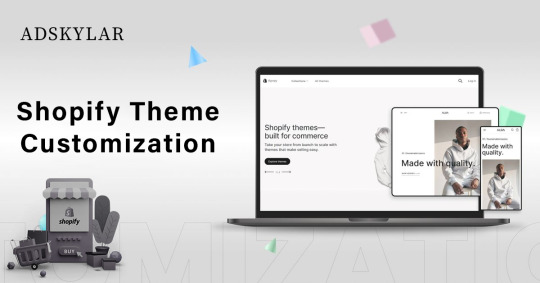
It must be quite clear that nothing can outshine the importance of a properly designed online Shopify store in persuading clients to themselves make purchases. Shopify offers an option for customizing themes to the owners of the different shops to personalize the site's views, user experience delivery, and business branding. Be it changing colors, fonts, layouts, or functionalities; it doesn't depend; customizing your Shopify theme will ensure that your store has an appearance that embodies the identity of your brand as well as application to meet your business needs.
Importance of Theme Customization in Shopify
This will create a unique and professional look for your store. Let us have a look at some reasons that make the customization of Shopify themes important:
Identity: The theme is customized according to your brand colors and fonts, as well as images, thus adding more identity to it.
Improved Navigation: Simple and easy navigation along with the added design features that make it easy to shop and browse when on searching.
Increased Conversion: Construction of a user-friendly and appealing store can create more chances of increased conversion rates.
Mobile Responsiveness: Great visibility on all devices due to being customized and more accessible.
SEO Optimizing: A well-structured and coded theme can enhance the search engine rankings for the store.
How to Customize a Shopify Theme
You can customize your Shopify theme according to your technical skill and requirement for your business in different ways. Following are some of the different ways:
1. Using Shopify's Theme Editor
Shopify has a built-in theme editor that allows you to make simple customizations without coding. You can:
Change colors, fonts, and layout settings.
Add or remove sections, such as level banners, testimonials, and product grids.
Modify homepage, collection pages, and product pages easily.
2. Editing Shopify's Theme Code
For extensive customizations, you can change the theme's Liquid code along with HTML, CSS, and JavaScript. This is the method to:
Make particular checkout pages and cart functions.
Change your product pages with custom fields or layouts.
Improve some parts of the design, like buttons, headers, and footers.
3. Employing Shopify Apps for Customizing the Store
Shopify App Store is filled with hundreds of apps that can make your theme customization simpler. These apps allow you to:
Utilize countdown timers, pop-ups, and banners.
Include advanced filter and search capabilities.
Encourage enhanced user experience through quick view and wishlist features.
4. Hire a Shopify Developer
For that professional touch, hiring a Shopify developer can help your theme customization get done accurately and efficiently. Developers will be able to:
Bring about the creation of tailor-made custom Shopify themes.
Optimize speed and performance.
Seamlessly integrating third-party tools and plugins.
Best Practices for Theme Customization on Shopify
Herein published are the best practices for custom-tuning your Shopify theme to achieve the greatest results:
Keep It Simple: Sources indicate that many design elements could introduce latency to your site.
Make Sure It Is Mobile Compatible: Test the changes on diverse devices to create a hassle-free user experience.
Speed Optimized: Use well-optimized code and compress the images to ensure that your site is running at a fast speed.
SEO Guidelines: Make friends with SEO through its very SEO-compatible URLs and the alt text of images and meta tags to rank higher.
Backup Your Theme: It's always wise to back up your theme before making any changes, so you don't lose important data.
Customizing a Shopify theme is taking a step further to improve the feel, functionality, and user experience of your store. Whether you want to customize a theme easily using the theme editor or you dive into advanced coding, it is possible to create a store no less than that which will represent your brand and attract new customers more. Building the most professional yet highly converting online store will now be very easy when best practices and tools of Shopify are combined.
0 notes
Text
Top Shopify Review Apps to Boost Your eCommerce Sales
Customer reviews are a game-changer for any online business. A well-structured eCommerce website design with a robust review system can significantly enhance trust and drive conversions. Whether you're focused on eCommerce website development or improving your Shopify website development, choosing the right review app is crucial.

1. Judge.me – Best for Affordability & Features
Judge.me offers a seamless interface, automated review requests, and SEO-rich snippets for better visibility. Its free plan is feature-packed, while the paid plan ($15/month) unlocks photo/video reviews and branding removal.
2. Loox – Best for Visual Reviews
Loox focuses on image-based reviews, offering a social proof widget and referral incentives. Plans start at $9.99/month, making it ideal for brands prioritizing visual content.
3. Trustoo – Best Budget-Friendly Option
Trustoo provides photo reviews, Google snippets, and automated follow-ups at competitive pricing. With plans from $9.99/month, it’s a great choice for cost-conscious merchants.
4. Fera Reviews – Best for Storewide Ratings
Fera integrates product and overall store ratings, boosting credibility. It supports reviews from multiple platforms and offers automation tools for seamless management.
5. Growave – Best All-in-One Solution
Growave goes beyond reviews, combining loyalty programs, referrals, and wishlists, making it a perfect marketing tool for Shopify stores.
6. Yotpo – Best for Scalability
Yotpo is a comprehensive Shopify website development tool offering advanced marketing integrations alongside its review system. Ideal for growing businesses.
7. HelpfulCrowd – Best for Authenticity
With a strong focus on genuine customer feedback, HelpfulCrowd supports Q&A widgets and social review displays, ensuring trustworthiness.
Final Thoughts
A well-chosen review app enhances engagement and credibility. If you're focused on eCommerce website development, integrating customer feedback into your eCommerce website design is essential. From Judge.me’s affordability to Loox’s visual appeal, pick the app that best fits your needs to maximize conversions!
#ShopifyApps#eCommerceSuccess#BoostSales#ShopifyReviews#CustomerFeedback#ShopifyStore#OnlineBusiness
0 notes
Text
eCommerce Development: Your Complete Guide to Building a Successful Online Store

The digital age has changed the way businesses operate, and eCommerce is at the heart of that transformation. Whether you’re a small business owner or a major brand, developing an online store is essential for reaching customers where they already are—online. But what goes into eCommerce development, and how can you ensure your store succeeds in the competitive digital marketplace?
In this article, we’ll explore everything from the basics to the intricacies of building a strong, customer-friendly eCommerce website.
What is eCommerce Development?
At its core, eCommerce development refers to the process of creating and managing an online store where goods or services are sold. This includes everything from designing the layout and structure of the website to setting up payment gateways, integrating security features, and optimizing the user experience.
But developing a successful eCommerce store isn't just about throwing products on a website. It's about creating a seamless, engaging experience that compels visitors to stay, explore, and most importantly—buy.
Why is eCommerce Development Important?
In today’s fast-paced digital landscape, customers expect convenience, accessibility, and a frictionless shopping experience. Your eCommerce website is often the first interaction someone has with your brand, so it needs to make a strong first impression. Think of it like a brick-and-mortar storefront. If your windows are dirty and your layout is confusing, customers won’t stick around. The same goes for your online store.
A well-developed eCommerce platform:
Increases brand visibility – People can discover your business through search engines, social media, and direct searches.
Provides round-the-clock service – Your store is open 24/7, allowing sales even when you're asleep.
Enhances customer engagement – Features like reviews, wishlists, and related product suggestions keep users coming back.
Streamlines operations – Automated inventory management, order processing, and customer service tools can save you a ton of time.
Now that we’ve covered the “what” and “why,” let’s dive deeper into how to get started with eCommerce development.
Key Steps in Developing an eCommerce Store
Creating a successful eCommerce website involves multiple layers of development, from design and technology to user experience and marketing. Let’s break down the critical stages.
1. Choosing the Right Platform
Before anything else, you need to decide which platform will serve as the foundation of your eCommerce store. There are several popular options out there, each with its pros and cons.
Shopify – Known for its ease of use and robust app ecosystem.
WooCommerce – A WordPress plugin that provides flexibility and scalability.
Magento – Offers advanced customization but is better suited for larger, more complex operations.
BigCommerce – A hosted solution that provides powerful out-of-the-box features.
When selecting a platform, consider factors such as:
Budget
Ease of use
Customization options
Scalability
SEO features
Your platform is the backbone of your business, so choose wisely!
2. Designing the User Interface (UI) and User Experience (UX)
The design of your eCommerce site can make or break the user experience. If users struggle to navigate your website, they’ll bounce before they ever make a purchase. Prioritize simplicity and functionality while still maintaining a professional, on-brand look.
Best Practices for UI/UX:
Mobile responsiveness – With over half of online shopping happening on mobile devices, your site must look great on every screen size.
Easy navigation – Intuitive menus, search bars, and clearly defined categories improve the shopping experience.
Fast load times – No one has time to wait for slow-loading pages. Keep your design light and optimized.
Clear calls-to-action (CTAs) – Make it obvious where you want users to click, whether it’s “Add to Cart” or “Learn More.”
Pro Tip:
Think of your site as a digital store layout. Just like in a physical store, you want to guide your customers effortlessly from browsing to checkout.
3. Setting Up Payment Gateways and Security
You wouldn’t buy from a store that doesn’t feel secure, would you? The same goes for your customers. Integrating reliable, secure payment gateways is crucial.
Popular payment gateways include:
PayPal
Stripe
Square
Apple Pay
You’ll also need to implement security features like SSL certificates to protect customer data, particularly when it comes to handling sensitive information such as credit card numbers. Trust is everything in eCommerce, and any breaches can devastate your business.
4. Optimizing for SEO
What good is an amazing online store if no one can find it? Search Engine Optimization (SEO) ensures that your website ranks high on search engines like Google, bringing organic traffic your way. This step is vital for long-term success.
Basic SEO Strategies:
Keyword research – Know what terms your customers are searching for and incorporate those into your product descriptions, headings, and meta tags.
Optimized URLs – Keep URLs short, descriptive, and SEO-friendly.
Image optimization – Use relevant alt text and compress images to improve load times.
Blogging – Consistently publish valuable content to keep your site fresh and improve search rankings.
Remember, SEO is a marathon, not a sprint. Regular updates and ongoing optimization are key.
5. Testing and Launching
Before going live, rigorously test your website. Check for any broken links, slow-loading pages, or issues with your checkout process. Try your site on multiple devices and browsers to ensure a seamless experience everywhere.
Once everything looks good, it’s time to launch!
Post-Launch: Maintaining and Growing Your eCommerce Business
The journey doesn’t end once your store is live. If anything, it’s just beginning. Maintaining a successful eCommerce site involves constant updates, customer feedback loops, and ongoing marketing efforts. Here are a few things to keep in mind after launch:
1. Customer Support and Engagement
Provide excellent customer service through live chat, email support, or even AI chatbots. Keep customers engaged with email marketing, loyalty programs, and personalized offers.
2. Performance Tracking
Keep an eye on your analytics. Google Analytics, Hotjar, and your platform’s built-in tracking tools can give insights into your visitors’ behavior. Are they dropping off at a certain point in the checkout process? Are they spending enough time on product pages?
3. Scaling Your Business
As your business grows, so will your needs. You may need to expand your inventory, upgrade your hosting plan, or even redesign your website. Stay adaptable!
youtube
Final Thoughts
Building an eCommerce store is like planting a seed. With the right platform, strong design, proper SEO, and customer engagement, your store will grow and flourish in the competitive digital marketplace. Take the time to develop a strategy, focus on user experience, and most importantly—never stop improving.
#eCommerce development#ecommerce development company#ecommerce development services#ecommerce development agency#Youtube
1 note
·
View note
Link
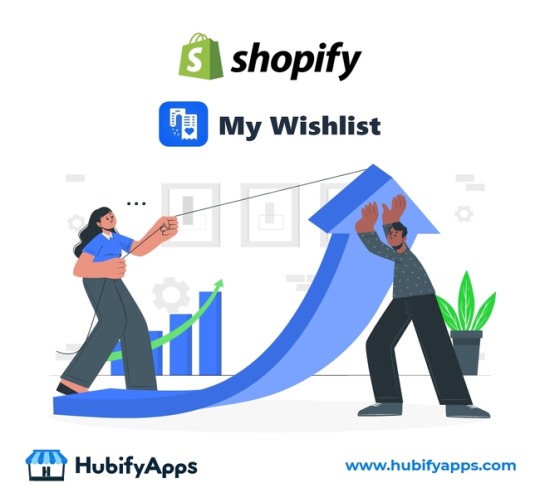
1 note
·
View note
Text
5 Essential Things To Keep in Mind While Setting Up a Shopify Store

Operating an eCommerce shop is not the same as running a personal blog. There's a lot more to keep track of, such as email marketing, secure checkout, shipping, and speed optimization. Fortunately, we've compiled a list of some of the finest Shopify applications to assist you in managing your web store and adding new functionality. Shopify is used by over 1,000,000 enterprises to manage their online stores.
It's easy to understand why, because Shopify makes it simple to start an online store, allowing you to automate sales, shipping, and even marketing. The Shopify App Store, like the WordPress Plugin Directory, is brimming with fantastic apps for expanding the functionality of your ecommerce store and growing your business. It's not always simple to sift through thousands of applications to find the one that's right for your company.
Best Shopify apps: Make sure you choose the best Shopify apps who offer you distinguished features that you indeed require to generate more profits. People who work behind these apps are professionals, who are well versed with their work and deliver them with utmost perfection, hence it becomes extremely significant for you to hire such professionals, who not only look after the interface of your business but also help you devise incredible marketing strategies. They will come up with unique ideas to increase your conversion rates and sales. Will make your ecommerce store look as user friendly as possible by giving it a simple yet elegant look.
Significance of a landing page: A shopify app will make your landing page look as beautiful as possible for it may attract thousands and millions of people to your store. They will execute their work with utmost care and perfection making your landing page look as simple as possible, because if you make it too intricate it will be difficult for your visitors to comprehend the interface thus making them leave your site as soon as possible. Make sure your landing page has a high volume of creativity, and is incredibly user-friendly in nature so that your potential customers don’t have any problem understanding the functionality of your landing page of the e-commerce store or website.
Need to change regularly: Your material should be updated on a regular basis, with a new set of keywords, in order to attract as many visitors as feasible. It is important to maintain your material over time, otherwise your site or shop name will become outdated and monotonous, preventing it from appearing in the top search results, which may be detrimental to the growth of your business. To prevent such difficulties, we must alter the material and make it as distinctive as possible in order to attract as many people/visitors as possible, which may be beneficial in delivering the maximum traffic to your site. Installing the best Shopify Product Review App can help you get all the reviews from your customers, thus helping you to be aware of the features that might need an upgrade. It boosts your profits and retains the customers which you have already gained.
Perks of selecting the Best Shopify Review App: Choosing the best shopify review app would help you figure out the areas you need improvement. The app enables a two way communication process which would help you to engage with your customers and encourage each other to be a part of the sales. Review apps for shopify can be instrumental in taking bulk actions, which might enable you to publish, hide and manage reviews quickly and easily. The best shopify review apps will help you customize and edit your layout, text and colours without needing a code. Don’t forget to add your review scores to your google search results which could help you gain more reach in future and help the netizens be more aware about your brand.
Significance for opting the best Shopify loyalty app: There are many apps such as Growave, ReferralCandy, Smile.io and many more that might provide you with an all-in-one marketing tool for Shopify stores. These might offer you with multiple loyalty programs, wishlist and review features that might be useful in boosting your conversion rates. Also what better way to win over your customers than by giving them a few extra perks. Rewarding points is an excellent way to increase client loyalty. According to research, loyal clients spend 67 percent more than new ones, which is extremely advantageous to business owners. Shopify users have access to a plethora of fantastic applications that may assist you in implementing your own incentive programmes to increase client retention. These apps might help you devise some extraordinary loyalty programs for your business or even come up with coupon giveaway ideas. With the help of these apps, in only a few clicks, retailers can establish a beautiful and personalised rewards programme. Moreover, the platform does not restrict you to simply rewarding your clients after they have made a purchase. Instead, you may award points for a number of reasons, such as product evaluations, account registration, newsletter subscription, or social network sharing, it completely depends on how you want it to be.
These are the few things that you should keep in mind as a merchant before setting up an ecommerce business and above everything, always remember to stand unique and never step back from experimenting with new ideas, that might actually have the potential to do wonders in the world, which welcomes bizarre ideas without any judgements. The more creative you are with your ideas the more successful your business will become.
1 note
·
View note
Text
7 Referral Apps Shopify Plus Brands Trust for Sustainable Growth

Why Referral Marketing Beats Discounts and Ads
As acquisition costs keep rising and consumer trust in ads continues to drop, brands are rethinking how they grow. On Shopify Plus, where you’re already investing in scale, the smartest move isn’t more discounting but turning your best customers into your loudest advocates.
That’s the power of a referral program: sustainable, high-ROI growth driven by people who already love your brand.
But referral marketing only works if the execution is smooth, rewards are automated, and everything runs natively inside your Shopify Plus setup.
What Makes a Good Referral Program on Shopify Plus?
Before diving into the tools, here’s what you should look for:
Shopify Plus native integration
Dual-sided rewards (for referrer + friend)
Custom branding to match your store’s identity
Automation for emails, tracking, and redemption
Built-in analytics to monitor what’s working
Mobile-ready experiences
7 Best Referral Program Tools for Shopify Plus in 2025
1. Nector – Loyalty and Referrals, Seamlessly Combined
Nector is more than just a referral app; it’s a full customer loyalty engine built for retention-focused Shopify Plus brands.
Why it stands out:
Combines loyalty, points, and referrals in one system
Gamified widgets and branded referral pop-ups
Easy dual-sided reward setup
Advanced analytics and segmentation
Fully compatible with Shopify Plus APIs
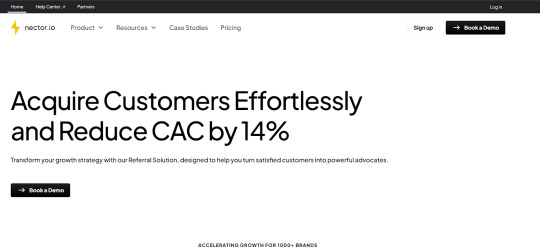
If your goal is long-term customer engagement, not just short-term spikes, Nector helps you build a referral system that fits into your broader retention strategy.
🟢 Best for: Brands that want a loyalty-referral flywheel.
2. ReferralCandy – Get Your Program Live in Under an Hour
If you want to launch a referral campaign fast, ReferralCandy is built for speed and simplicity.
What you get:
No-code setup
Pre-built referral email templates
Shopify and Klaviyo integrations
Basic fraud protection
It’s one of the most accessible tools out there, with thousands of Shopify brands already using it.
🟢 Best for: Quick-launch referral programs.
Read more on Referral Marketing
3. Yotpo Referrals – The Referral Layer for Review-Driven Brands
Already using Yotpo for reviews, SMS, or loyalty? Yotpo Referrals makes it easy to add a referral program without adding a new platform.
Top features:
Post-purchase referral prompts
Cross-channel marketing (SMS, email, on-site)
Unified analytics with other Yotpo tools
Seamless Shopify Plus integration
🟢 Best for: Brands already using the Yotpo ecosystem.
4. Talkable – Deep Customization and Performance Optimization
Talkable gives you full control over your referral program, ideal for brands with advanced segmentation and testing needs.
Why advanced brands love it:
A/B testing built into campaign creation
Anti-fraud tech to protect high-value referrals
Dedicated onboarding support for Shopify Plus
Flexible rules and reward structures
🟢 Best for: Data-driven teams and high-volume stores.
5. Friendbuy – Clean Design Meets Powerful Automation
Friendbuy balances ease of use with sophisticated logic for referral reward triggers.
Key benefits:
Clean UI that matches your brand
Fully responsive mobile-ready flows
Event-based reward logic
Shopify Plus native app
If customer experience matters as much as performance, Friendbuy’s design and flexibility will appeal to your team.
🟢 Best for: UX-first DTC brands scaling fast.
6. Smile.io – Loyalty-Driven Referrals Made Simple
Smile.io’s referral module ties directly into its well-known loyalty program, making it perfect for brands already invested in Smile.
What you get:
Points-based referrals
Easy sharing dashboard for customers
Shopify Plus and POS support
No-code configuration
🟢 Best for: Brands already running Smile loyalty programs.
7. Growave – Affordable All-in-One Customer Engagement
Growave offers more than referrals, it includes reviews, wishlists, loyalty, and social login too. Its referral module is perfect for emerging brands.
Why it’s worth considering:
Budget-friendly plans
Influencer and micro-referral friendly
Strong for community-based brands
Social sharing tools built-in
🟢 Best for: Small-to-mid Shopify Plus brands building organic communities.
Final Words
You don’t need a massive ad budget to grow anymore. You need the right incentives, the right software, and a loyal customer base ready to refer their friends.

All 7 of these tools give you the infrastructure to do with deep customization, others with fast rollout. Whichever you choose, ensure it aligns with your retention strategy, your brand voice, and your customer journey.
👋 Pro tip: Start small. Test one referral campaign. Optimize based on real data. Then scale.
Ready to make your customers your best marketers? Click HERE
0 notes
Text
Ultimate Guide to Sell Your Product On Instagram
Ultimate Guide to Sell Your Product On Instagram
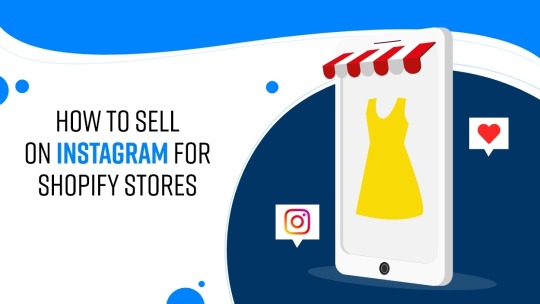
Instagram is a leading social media platform nowadays. from the small business to big brands almost everyone uses this platform to increase their store sales, build a loyal following, and take their business worldwide.
Why Instagram is Needed
According to surveys, an engaged follower on Instagram is worth more than Facebook, when compared in the aspect of the average order value of their purchases ($65 vs $55).
Another study proves that about 72% of Instagram users make a purchase decision right after discovering a product on the social media platform.
So let’s get started on how to sell on Instagram.
Set up Shopify’s Instagram Channel
You need to set up Shopify’s Instagram channel to To Start selling products on Instagram.
But before you add the channel, you have to make sure that you have a Facebook business page, and that you have added products to your Facebook catalog.
Also read: Setting up your Instagram channel after making a Facebook product catalog
1. Tag products on your photos
When users come across your post, they can tap on the photo and see a product tag. When they click on the tag, they can view the product listing, including other pictures, pricing, and other similar products that the store sells.
You can enable this functionality by installing the Instagram app one of the best shopify apps for Instagram from the Shopify store.

2. Set up an Instagram Shops (not launched yet)
Instagram shops are another new feature of insta. With the feature, shoppers can view, browse, and check out products directly through Instagram.
Since the feature is still rolling out, merchants need to install the Instagram app on their Shopify store and keep an eye out for new updates. Once available, you can provide checkout functionalities on Instagram and simplify conversions.
3. Add the feed to store with InstaPics
By displaying your feed on your store, you can build trust and let shoppers connect with you better. You can embed your Instagram feed with InstaPics. The Shopify app is updated with the latest API, ensuring that your feed loads seamlessly. You can even customize this embedded feed to match your store’s design.
4. Make your feed shoppable with Cameo
Many brands enable this feature by sharing user-generated content, displaying images posted by their customers. With a shoppable Instagram feed, shoppers can click on an image and see every product within the image.
You can easily set up a shoppable Instagram with Cameo. The app is highly customizable and is responsive to different devices as well. This app will allow you to create a shoppable Instagram gallery and showcase on your site by which your followers and customers can buy from the Instagram photos easily
5. Enable wishlisting on Instagram
Instagram is slowly reinventing itself to cater to online shopping. One small feature available for users now is wishlisting. Merchants can enable wishlisting on their Instagram feed so that shoppers can bookmark a product. This would then appear as a ‘Wishlist’ collection on the user’s Saved Instagram section.
The Instagram app on the Shopify App Store allows you to enable this feature.
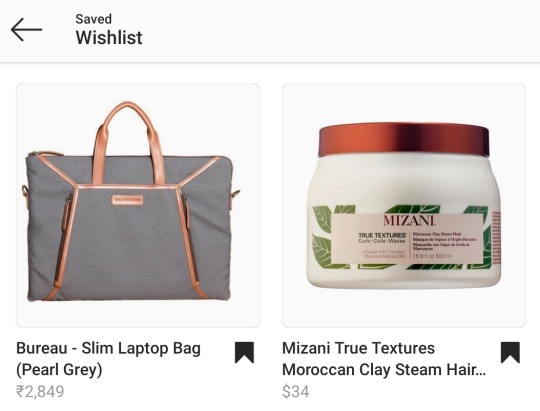
6. Run Instagram ads
Instagram’s potential advertising reach is 849.3 million users and consumers eager to interact with brands on the platform. By setting up high-converting ads, you can pull new audiences to shop from you, acquiring customers through this powerful platform.
If you don’t know where to start, you can reach out to Spin, a team of eCommerce ad experts, for free ad consultation. Their experience in running ads has helped many Shopify merchants improve their ads ROI by 625.49%
We hope this extensive guide helps you set up a winning strategy to sell on Instagram and grow your store.
Need any help in getting started on Instagram?
Instagram is a popular and growing platform and by leveraging the large audience at your fingertips, you can tap into the needs of these users and nudge them to shop your products. If you need any help to set up an Instagram feed on your shopify store, feel free to reach us.
1 note
·
View note
Text
Manifestation Techniques Require Awareness

15 Minute Manifestation is the right program that will make you capable of creating and having anything you need and want in your life. This method is a verified technique and has been advanced by Eddie Sergey. This system will routinely appeal to what you want, but you must follow it. This program will make you work hard towards your dreams and make them a reality. You can live your life the way you want to have an unlimited abundance of anything you want.
Manifestation Techniques Require Awareness
The solution obviously, is to cover a Headspace subscription, so that your private guru is currently an app, and it is going to set you on your course at a better life. The course gives you detailed written material along with video demonstrations of the use of the 15 minute manifestation review written material in the tradition of our faith and of our spiritual discipline. Over time, it is going to become how you're characterized. By the conclusion of it, it became clear to me how much time that I wasted on social networking, which resulted in the disappointment of not able to complete daily job, self-doubt and maybe even demise. Intentionthe most essential part of manifesting anything in your life is the intention you set in the start. The thing is, bisexuals that wind up in heterosexual relationships rarely project they are bi, since it's more convenient that manner. You're constantly in relation.
The less obvious, more subtle objective is to uncover the function of design in the customer's own procedure and work culture. The subsequent Mind Map can help you unpack the process to Christian maturity, while in addition envisioning you on how best to sustain a life of Christian maturity. Which is something which we still require. Falling out of love isn't a feeling that anybody takes lightly. In recent times there's been a rise in the access to instructional material in written form. The truth of the issue is it would be pointless to test for data where the outcomes are always likely to come out the same manner. Most our wishlist bullet points have come to be a reality through the usage of Shopify.
http://manifestationmiraclereviews.co/15-minute-manifestation-review/
1 note
·
View note
Text
WHY DO YOU NEED A SHOPIFY MOBILE APP?
Before we tell you why a mobile App – a mobile responsive website for your e-commerce store is NOT enough to be able to provide a mobile-friendly shopping experience and boost revenue, For the modern customer, in this case, unless you really do provide a good shopping experience. Either way, mobile app or a website.

See? Your customers don’t judge you for not having an app but they can move on to brands who have mobile shopping apps. If you already have a world-class, mobile responsive website that works perfectly fine. And for that we can say “Good job; that’s necessary, but not enough”.
And furthermore, do you want your customers to stop bothering you with their purchases? Because the modern customer expects you to provide a seamless & hasslefree shopping experience with an app and will move to a competitor if your mobile shopping experience is unsatisfactory.
You can Increase the sales & conversions with more than 100 effective features with a Shopify Mobile App. Reduce your checkouts abandoned: Abandoned checkout pop-ups and a one-step checkout guarantee that the customers complete their orders. WHY DO YOU NEED A SHOPIFY MOBILE APP DEVELOPMENT? Shopify mobile app quick to create, helpful to use for your customers, unified control for your whole necessities - Shopify mobile application delivers a powerful answer for your m-Commerce.
Engage Customers Better:
Using real-time push alerts boost shopper engagement 4x better. Do Email marketing; push is the latest text to generate traffic. Simple to-Use Mobile Apps - Enhanced User Engagement:Mobile Application work for Shopify Stores are incredibly simple to utilize, empower single-tap inventory access, and makes it convenient for your brand to arrive at a new height. Customers can browse the catalog effectively following the entire checkout process inside the App as it were. Consistent Synchronization of an App with your Shopify Backend:Need to make your store accessible on a mobile platform? Make it happen quick and simple. see your business channel develop with expanded user engagement. All orders and customers made on App will be synchronized consistently with your Store backend including real-time stock synchronization, and customer or order status. Better Performance and User Experience:In comparison with mobile-friendly websites, Mobile applications perform much better! Features like adding items to the wishlist. Your clients can install the Application once and quit looking on the web for the items you sell. Hire best Shopify Mobile App Development Company in CaliforniaHere is one Shopify-friendly expert agency that has been building leading Shopify stores and mobile applications. Before eBizTrait Technolabs was crowned as a dedicated Shopify development company, the team actively interacted with merchants and understood their pain points. This seriousness and willingness to work with merchants make eBizTrait Technolabs stand apart from other expert agencies. If you manage your eCommerce business with Shopify, then here’s how eBizTrait Technolabs can be useful – SHOPIFY MOBILE APP DEVELOPMENT SERVICES
Shopify Mobile Application Development
Mobile Store Setup
Custom-Tailored App Design and Development
Module Management
Customized Payment Gateway
Website to Shopify Mobile App Design and Development
Shopify Migration
Shopify App Store Management
App launch and After-Support Check our work, to ensure authenticity. Whether it's Shopify design and development, or mobile application development needs, or you need a full-service Shopify development company in California to handle your ecommerce store work, with you and get assured results!
#shopify#websitedeveloment#app development#ecommerce#shopify app development#california#small buisness
0 notes
Text
How to get an eCommerce Website & Mobile App in 30 days?

Launching an app for e-commerce is no longer a matter of why; it is about how to do it well anymore. Want to know the secret to get an eCommerce Website or Mobile App in just 30 days?
First, you must know that for any company/business, to access the worldwide audience concept of e-commerce solutions is a clever and affordable approach, but developing an online e-commerce business can become arduous if you don't know where to start. So, if you want an App for your Business within 30 days, here are the things to consider when building an eCommerce website.
Identify your Needs & Know your Audience
Knowing what you want is crucial. The features, your development approach, and more will directly influence your goals and KPI. After identifying your needs, think about your audience, target country, and where you want to sell your products. Answering all these questions can enhance the end product after developing your eCommerce Website or Mobile App and its marketing.
Select the Appropriate Technology
It is now time to decide, and it is the most important one about what technologies you want to use for your eCommerce Store.
There are two major options: progressive web apps and native apps are available by e-commerce companies offering web and mobile app development services. So even though you will research for the latest technologies and stuff but still help from an eCommerce development company is a must because no one can suggest what is best for your store than a full-fledged eCommerce development agency.
Find an eCommerce Platform that Suits your Requirements
For all those people whose searches include "how do I build an eCommerce website?" the good news is you can rapidly create your website with the proper understanding of e-commerce platforms such as:
· Shopify
· Wix
· BigCommerce
· WooCommerce
· Prestashop
· Magento
Even though these platforms are very easy to use, but consulting and engaging with a Mobile app Development Company is more beneficial. Their expertise will help you get many advanced features on your online store that require technical knowledge of coding.
Also read the seven lessons we have learned during our 18+ years of experience in eCommerce web development: https://netmaxims.com/blog/learning-in-website-development-in-18-years-seven-lessons-in-ecommerce-web-development-part-2/
List of eCommerce Application Requirements
Make a list of every feature that you will need in your App. FYI every eCommerce mobile app or eCommerce website requires unique features according to the services being provided. But here is a list of a few most common features that are necessary for every eCommerce store to improve the eCommerce customer Experience:
· Push messages
· Template selection
· Look-books
· Multiple payment options
· Easy checkouts
· Wishlists
· Back-end synchronization
· Native experiences
· Customer review or rating system
· Integration of social media platforms
Choose the Correct Budget & Methodology
You may select 1 out of 2 choices depending on the amount of investment you can make and the amount you need to be flexible: develop a bespoke app, or utilize a SaaS solution. Suppose you opt to build a bespoke app. In that case, you have to engage a company's development team providing eCommerce mobile app development services.
Promote Your App
It's vital to create eCommerce applications, but afterwards, promoting them is just as important.
The Conclusion
The e-commerce site building procedure requires some time and study, but the result is satisfactory. However, you can always take help from an eCommerce development company that will help you to create your online dream store. This article offers a brief guide for the development of an e-commerce website quickly.
If you wish to start with yours now, you can contact us for more information on eCommerce website services. In addition, we also offer cross-platform mobile app development services because we understand specific market requirements and design strategies by using the power of cross-platform technology to build the correct solutions.
#eCommerce website development#ecommerce web design company#custom mobile app development company#ecommerce website services#concept of eCommerce#eCommerce development company#hire mobile app developer#Mobile App Development Company#Mobile App Development Agency#Android App Development agency#website development agency#web development company usa#web development companies in europe#web development in germany#web and mobile development services#ecommerce mobile app development services
0 notes
Text
Best Shopify Wishlist Apps for Increasing Sales
E-commerce has become a vital part of retail, and Shopify stands out as one of the most popular platforms for online businesses. For Shopify store owners, finding ways to enhance user experience and boost sales is paramount. One effective strategy is incorporating wishlist apps. These apps provide customers with functionality for saving items of interest
0 notes